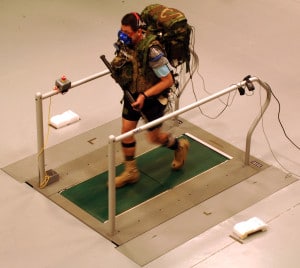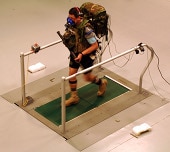Everyone on the Left Coast is tweeting about Google Glass this week. But, let’s face it, @projectglass is really about dis-intermediating the viewing screen. Now, over at DARPA’s Web site, we really get to see what the future of intelligent apparel looks like, namely: the DARPA Warrior Web, a next generation augmenting and intelligent uniform.

DARPA on Wednesday released photos and a video of a soldier wearing a Warrior Web prototype, which augments “the soldier’s own muscles to significantly boost endurance, carrying capacity and overall war fighter effectiveness.” The prototype shown is one of many under evaluation by the Army with the goal of providing increased protection to soldiers and reducing the “metabolic cost of carrying a typical assault load” – which is often in excess of 100 lbs, according to DARPA. Muscular-skeletal injuries due to wear and tear are a leading cause of soldiers not being deployed to action.
Of course, the suits aren’t just about enhancing the physical strength of soldiers. Eventually, they’ll be expected to be self-healing features to assist with healing of acute injuries. They will also be equipped with a web of sensors that can give realtime feedback to the soldier and his or her commanders.
The Warrior Web program dates to 2011, when DARPA issued a request for proposals for a next generation suit that could help prevent injuries and stress on soldiers. The project has five main “thrusts,” according to DARPA: injury mitigation; comprehensive representations of biomechanical processes; regenerative actuation (sp) technologies; adaptive sensing and control technologies; and advancements in potential suit human-to-machine interfaces.
The suit shown in the demonstration video is minimal – a soldier in shorts and a t-shirt carries a fully loaded pack and mock weapon on a treadmill. Attachments to his lower extremities – which look like sock garters – drive his legs as he walks.
During a follow-on phase, DARPA will attempt to produce a finished suit based on the prototypes submitted in the initial phase. It is intended to weigh under 20 lbs and consume no more than 100 Watts of electric power from a battery source.
DARPA in an earlier incarnation developed ARPANET, a precursor to the public Internet. In recent years, DARPA has used RFIs and a variety of open contests to delve into areas relevant to war fighting and defensive technologies. They include the DARPA Robotics Challenge, and cyber defense related programs like MNP – The Military Networking Protocol, The Cyber Insider Threat (CINDER) program and Cyber Fast Track (CFT), a program to collect and quickly approve skunkworks projects related to pressing cyber security problems.

